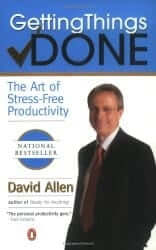You know the feeling when you’re confronted by a mountain of tasks that paralyses you?
You just look at all the stuff you’ve got to get done and you go limp.
Your shoulders slump. Your heart sinks.
 It feels like a pointless battle.
It feels like a pointless battle.
You think to yourself: “Why bother working through this crap load of email when I know there’s going to be a ton more by the time I’m done actioning these?”
Fact : We live in a hyper connected world.
A world which isn’t very forgiving of unread emails in inboxes.
Some folks try to use email as a CYA (cover your ass) strategy, while others just shamelessly forward stuff to others trying tho shift responsibility. (Not a very professional approach but a popular one nevertheless)
And simplifying workflows through prioritisation and elimination is a great way to begin. But it will only take you so far.
What happens when you’re done prioritising and you’re still faced with a daunting list?
Enter David Allen’s Getting Things Done approach – GTD.
David Allen wrote a book called Getting Things Done which outlines a devastatingly simple approach to productivity at least in terms of it’s underlying principles. Some of the details can get quite involved – and in my opinion unnecessarily so.
For this reason, I’ve kept this post on GTD quite simple and high level.
One of of my other posts examines GTD more closely – particularly in terms of Omnifocus – the best GTD implementation software around.
Anyway, here’s my take on GTD in it’s simplest form:
1) As you go through your day record each task on your “to do list” in an easily accessible repository e.g. you iPhone (Siri is a very useful tool) . It is important to record each and every task because getting all these tasks out of your head and onto a trusted system is a very important step in freeing up a lot of mental energy that can be re-deployed to the present moment
2) Associate each task with a project (a collection of tasks that lead to an overall outcome) and a context (a set of conditions necessary for the given task to be executed. This could be a location, device or a person e.g. Work, Home, Phone, Computer etc)
3) Filter or batch your tasks by the context to execute all the tasks from the various projects at that location/context  i.e. the tasks in the ‘work’ context will appear under work and those in the home context will appear under home. You can have an unlimited amount of contexts.
The above steps can be very easily achieved by using an application called Omnifocus Omnifocus is available for the Mac, iPhone and iPad
(This post includes affiliate links. By purchasing items via these affiliate links you’re helping me earn a small commission at no additional cost to you. This enables me to provide you with good quality FREE content. The more you click the harder I work. :-))

